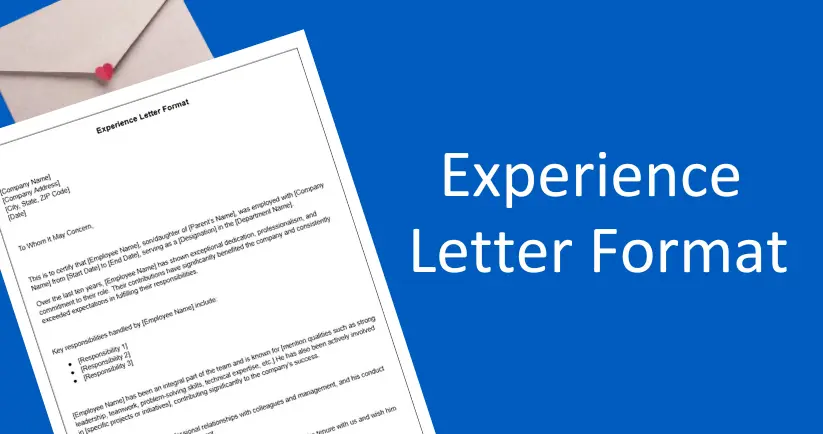business-services

June 06,2025 • 4 min read
Experience Letter Format: A Complete Guide with Sample Template

An experience letter is an essential document issued by an employer to an employee when they leave an organization. It serves as proof of employment and outlines the employee's role, duration of employment, and overall performance. Whether you're an HR professional preparing a letter or a job seeker wanting to know what to expect, understanding the correct experience letter format is crucial.
In this article, we’ll walk you through what an experience letter is, its key components, how to format it, and provide a sample template you can use right away.
What is an Experience Letter?
An experience letter is an official letter provided by an employer to an employee upon resignation or completion of a job. It confirms the employee’s job title, employment period, responsibilities, and conduct during their tenure.
This document is typically required by new employers during the hiring process, especially in formal or regulated industries. It can also support visa applications or higher education admissions.
Key Elements of an Experience Letter Format
A professional experience letter typically includes the following components:
1. Company Letterhead
The letter should be printed on the organization’s official letterhead, which includes the company logo, name, and contact information.
2. Date of Issuance
The date when the letter is issued should appear at the top right or left of the letter.
3. Recipient's Name (Optional)
While experience letters are usually addressed "To Whom It May Concern," it can also mention the employee's full name clearly in the body.
4. Employee Details
Include:
-
Full name of the employee
-
Job title/designation
-
Department or team
-
Period of employment (Start date to End date)
5. Roles and Responsibilities
A brief but specific description of the key responsibilities the employee handled.
6. Performance and Conduct
An optional but beneficial section, commenting on the employee's work ethic, attitude, and performance.
7. Conclusion and Best Wishes
A courteous closing statement wishing the employee success in future endeavors.
8. Authorized Signature
Name, designation, and signature of the issuing authority (usually the HR manager or supervisor), along with the company seal if applicable.
Experience Letter Format Template
Below is a standard, professional experience letter format that you can easily adapt to any industry:
[Company Letterhead]
Date: [DD/MM/YYYY]
To Whom It May Concern,
This is to certify that Mr./Ms. [Employee’s Full Name] was employed with [Company Name] as a [Job Title] in the [Department Name] from [Start Date] to [End Date].
During their tenure with us, [he/she/they] was responsible for:
-
[Responsibility 1]
-
[Responsibility 2]
-
[Responsibility 3]
-
[Etc.]
[Mr./Ms. Last Name] has demonstrated strong [mention key qualities – e.g., leadership, communication, analytical] skills and was a valuable member of our team. [He/She/They] maintained a professional attitude and fulfilled their duties diligently and with integrity.
We wish [him/her/them] all the best in [his/her/their] future professional endeavors.
Sincerely,
[Authorized Person’s Name]
[Designation]
[Company Name]
[Contact Details]
[Official Signature and Seal]
Tips for Writing a Strong Experience Letter
-
Keep the tone professional and neutral.
-
Use the company’s official format and branding.
-
Avoid overly personal opinions or informal language.
-
Be honest but positive in performance comments.
-
Double-check the dates and spelling of names and titles.
Sample Use Cases
-
Job Applications: Most commonly used when applying for a new job to validate prior experience.
-
Visa Processing: Often required for skilled worker visa applications to confirm qualifications.
-
Higher Education: Universities may request it for admissions into business or executive programs.
-
Professional Certifications: Some bodies like PMP or ACCA request proof of work experience.
Conclusion
Understanding the proper experience letter format is important for both employees and HR professionals. For employees, it serves as a crucial part of your career portfolio, and for HR departments, it reflects the professionalism of the organization. Always ensure that experience letters are issued accurately and promptly, as they play a vital role in career development.
Lucy Anderson Details
User Profile
- Full name
- Lucy Anderson
- Email address
- lucyanderson1617@gmail.com
- Join Date
- 2025-05-19
- State
- City
- Pincode
- Address
- Follow us on Facebook
- Follow us on Twitter
- Website Name
- Bio